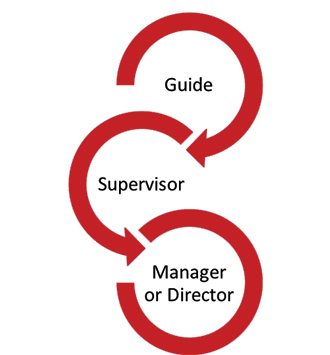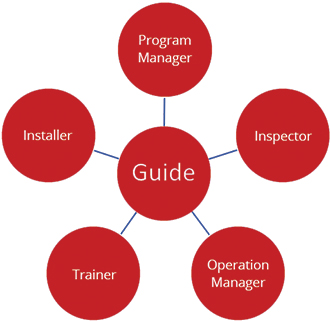The industry has experienced a transformation in the last 15 years—from ropes courses built for programs like Outward Bound and zip line and canopy tours that started in Costa Rica, to aerial adventure parks in many major cities in the U.S. (and the world). The U.S. Department of Labor forecasts a nine-percent growth in employment for recreation workers from 2016 to 2026. Our industry will likely experience greater growth than that. Consider: The number of aerial adventure parks has doubled in the past five years, and growth remains strong.
How might you fit into this expanding world? To provide you with some direction, develop a career plan. Here’s how to put one together.
The steps required for planning your career are straightforward:
1. Start with a self-assessment of your knowledge, experience, and skills (KES).
2. Get information about the careers that you are interested in obtaining.
3. Seek out experience and opportunities for professional development.
4. Keep records and document your professional experiences.

A career plan not only defines what success looks like in your chosen career, but it also gives you a map to get there. Plus, a career plan helps you explore opportunities and develop new skills along the way.

The linear path.
It’s important to understand that in a growing and changing industry, a career path might not be linear. The linear path, which many have taken, moves from guide, to supervisor, to manager/director. But there are other possibilities. You might start as a guide or office staff, then move on to become a builder or training specialist, for example. The graphics here suggest two different possibilities.

The non-linear path.
Self-Assessment. The self-assessment is a key step. It should include your KES, your interests, your personality, your abilities, and the lifestyle that you would like to have. For example, do you have woodworking skills that can be applied to make challenge course elements and platforms? Do you have accounting skills or an accounting degree that qualify you to run the financial aspects of the business? Do you like to work with people and see them grow in a challenging environment? Do you want to have an outdoor lifestyle? Identifying your interests is key in crafting a career plan.
In John Holland’s book, Theory of Career Choice, he maintains that most people are one of six different personality types. He created an instrument to help identify those personality types, which in turn can help people identify a work environment or path that fits their type. Holland’s theory states that the more you can express your personality in the workplace, the higher your career satisfaction is going to be.
With this understanding in mind, you can proceed to the next steps with clear purpose.
CAREER PATHS
Three main job categories are:
1. Facilitator, Guide, Trainer. This is the entry-level position for most staff, and includes some supervisory staff as well.
The course facilitator in a challenge course is responsible for facilitating a transformative experience to a group using initiatives and low and high elements. This person uses the challenge course as the vehicle for delivering a transformative experience.
The adventure guide for an aerial adventure park, canopy tour, or zip line tour is responsible for leading a group of guests on a series of zip lines going from point A to point B to point C.
The trainer is an experienced facilitator or guide who trains the new facilitators or guides. The trainer has advanced technical knowledge of equipment, knots, rescues, etc., and should also have interpersonal skills and the ability to teach soft skills (i.e. communication skills, customer service, etc.).
Typical compensation: $11-$15/hour, depending on the park location and size of the operation. Trainers and leads typically earn a bit more than those they train or supervise.
2. Operations Manager, Program Manager, Administrator. This person is responsible for the day-to-day operations of the course—from doing the morning inspection to hiring and training the guides. Also, managers have the fiscal responsibility of the park. Duties may include managing the budget, with responsibility for profit and loss, balance sheets, and revenue forecasting. Ordering supplies and paying independent contractors might also be part of the job as well.
Often, this also includes the safety management aspects of the whole park. Some larger operations have a safety manager who is responsible for the overall risk and safety management of the park or facility.
Some operations may divide the management duties into two positions: a program manager, focused on the programmatic aspects, and an operational manager focused on the day-to- day operation of the park including the equipment, integrity of the course, etc.
Compensation for these positions is often in an annual salary range of $35,000 to $45,000, depending on experience. For larger, high-volume organizations or those where the cost of living is high, the salary range may be higher.
3. Inspector, Installer, Designer. These support services roles include a wide range of options.
Inspectors are certified by an organization such as ACCT. The main job is to visit aerial adventure operations and inspect every cable, every bolt, and every tree or pole in an objective way, and write a report that catalogs what criteria a park is meeting, and what criteria it is not meeting.
An installer, typically, has carpentry skills and can build platforms, install elements, and make repairs, among other things.
A designer is the person responsible for designing an aerial adventure park, canopy tour, zip line tour, or challenge course. This person should have experience with different course elements and know how they flow and interact with each other. The designer may also be the builder of the course.
Typically, most inspectors, designers, and installers work for a company; some then go out on their own. Becoming a certified inspector requires hours of documented experience prior to taking the certification test, and this experience is most easily gained through working with an established company.
Salaries vary greatly, depending on many factors including experience, location, and client base. For example, in a recent job posting for a builder lead, the pay was $25/hour. A listing for a construction superintendent said it paid $55,000 to $76,000.
PROFESSIONAL DEVELOPMENT
Professional development can take several directions: a higher education degree, immersion training, a certification, or learning from a mentor to gain the skills and knowledge needed to advance your career.
In this industry, we have a longstanding debate over the merits of being certified versus qualified. Both have their advantages and limitations. (Note that ACCT standards require certified individuals for certain jobs and qualified individuals for others.) Certification presents a valid way to verify your competencies based on industry standards. The certification states that on that day the person had these set of skills. Certifications are costly and hard to maintain due to the expiration dates (1-3 years.). On the other hand, a qualified person might not have a current certification, but possess the skills to perform the duties required.
Study job descriptions for positions that align with your career goals, and note any certifications that are required and the years of experience needed. Then define the skills needed and/or certification to be incorporated into your career plan. Note that there are industry certifications for practitioners, managers, and inspectors, among others. Medical certifications such as first aid and CPR or Wilderness First Responder are also required in many operations.
Keep records. Create a log or a portfolio where you keep track of all the times that you have taken a training, delivered a training, have attended a conference, and so on. This is a place to showcase your experience in this industry. There are different organizations that have templates to make this process easier, but a simple spreadsheet is a good tool to start with.
FINAL THOUGHTS
In summary, make a career plan and put it in writing. Start by creating a list of organizations or people that you would like to interview or talk with about a career in this industry. Find job listings that you would like to have, but are not qualified for yet. Create a map or a path to get the professional development needed to fill the KES gaps.
Also, if you haven’t already, start your portfolio, curriculum vitae, or log with all the trainings that you have taken and/or delivered to others. Create benchmarks along the way to make sure you stay on track. Make yourself accountable, and seek out the experience that you need to achieve your career goals.



